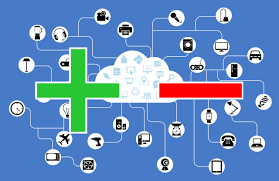Advantages and Disadvantages of IoT in Education

Advantages and Disadvantages of IoT in Education
The Internet of Things (IoT) has been making waves in various industries, and education is no exception. IoT in education encompasses the integration of smart devices and sensors to enhance the learning experience, streamline administrative processes, and create more efficient educational environments.

While IoT has brought about several advantages, it also comes with its set of challenges and disadvantages.
Advantages of IoT in Education
1. Personalized Learning
According to Wikipedia The use of the term “personalized learning” dates back to at least the early 1960s, but there is no widespread agreement on the definition and components of a personal learning environment. Even enthusiasts for the concept admit that personal learning is an evolving term and doesn’t have any widely accepted definition IoT devices can collect data on students’ learning habits and preferences. This data can be used to tailor educational content to individual needs, providing a personalized learning experience. Adaptive learning platforms can adjust the difficulty of content, pacing, and support resources to match each student’s abilities and progress.
2. Enhanced Classroom Experience
Smart classrooms equipped with IoT technology can transform traditional teaching methods. Interactive whiteboards, connected tablets, and smart projectors enable teachers to create engaging and dynamic lessons. Students can participate actively through their devices, fostering a more interactive and collaborative classroom environment.
3. Improved Administrative Efficiency
IoT can simplify administrative tasks in educational institutions. For example, RFID technology can be used for attendance tracking and access control, reducing the administrative burden on teachers and staff. Smart building management systems can optimize energy usage, saving costs and promoting sustainability.
4. Remote Learning
IoT enables remote learning by providing access to educational resources and virtual classrooms from anywhere. This is especially relevant during times of crisis, such as the COVID-19 pandemic, where remote learning became a necessity.
5. Safety and Security
IoT devices can enhance security on campuses. Smart surveillance systems and access control solutions can help monitor and secure the premises. Wearable devices can be used for tracking students in case of emergencies, providing an extra layer of safety.
6. Data-Driven Decision Making
Educational institutions can collect and analyze data on student performance and engagement, allowing for data-driven decision-making. This can help identify areas where students may be struggling and allow educators to intervene early to provide necessary support.
Disadvantages of IoT in Education
1. Privacy Concerns
IoT devices often collect vast amounts of data on students, raising concerns about data privacy. Protecting sensitive information and ensuring it is not misused is a significant challenge. Educational institutions must establish robust data protection measures and compliance with privacy regulations.
2. Technical Challenges
Implementing IoT in education requires a substantial technological infrastructure. This includes high-speed internet, device compatibility, and regular maintenance. Smaller institutions or those with limited resources may struggle to meet these requirements. EnoughInfo.Net
3. Cost
The initial investment in IoT technology for education can be expensive. Acquiring and maintaining smart devices, training staff, and addressing technical issues can strain educational budgets. Over time, however, these costs may be offset by increased efficiency and improved learning outcomes.
4. Security Risks
IoT devices can be vulnerable to hacking and cyberattacks. If not properly secured, these devices can expose sensitive educational data to potential breaches. Educational institutions must invest in robust cybersecurity measures to protect their networks and data.
5. Technological Gaps
Not all students have equal access to technology outside the classroom. This can create disparities in the learning experience, as students with limited access to devices or the internet may struggle to keep up with their peers.
6. Teacher Training
IoT implementation often requires teachers to adapt to new technologies and teaching methods. Training educators to effectively use IoT devices and platforms can be time-consuming and challenging.
In conclusion,
IoT has the potential to revolutionize education by providing personalized learning experiences, enhancing administrative efficiency, and improving safety and security. However, it also introduces privacy concerns, technical challenges, and security risks that need to be carefully managed. For IoT to be a successful addition to the education landscape, institutions must strike a balance between embracing innovation and safeguarding the interests of students and educators. How To Implement IoT in Smart City Infrastructure








